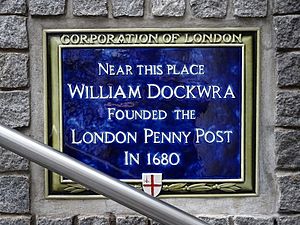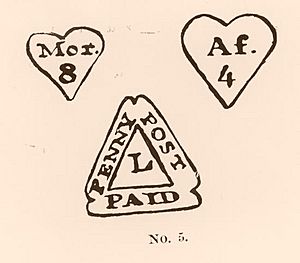London Penny Post facts for kids
The London Penny Post was a special mail service in London, England. It started in 1680 and delivered letters and small packages within the city and its nearby areas for just one penny. This was a very low price at the time!
The Penny Post was created by William Dockwra and his business partner, Robert Murray. They launched the service on March 27, 1680, after telling everyone about it for weeks. London really needed a way to send mail easily within the city. The Penny Post became a great example for other similar mail services that started later in England.
It was also the first postal system to use special hand-stamps. These stamps marked the mail to show where and when it was sent, and that the postage had already been paid. The Penny Post became very popular. However, its success caused problems for the existing General Post Office and for private messengers. It also got into trouble for sharing messages that criticized the government, especially the Duke of York. Because of this, the government eventually took over the Penny Post. The oldest known Penny Post mark is from December 13, 1680. Some people think it was the world's first postage 'stamp'.
Contents
Sending Mail in London in 1680
Before the London Penny Post, there was only one main post office in London. This office handled mail going outside the city. But there was no easy way to send letters or packages within London itself. People had to pay a lot to private messengers.
Dockwra and Murray's Penny Post changed this. It offered a much-needed service for London's growing population and businesses. With about half a million people living in London at the time, there was a huge demand for a local mail system. The Penny Post's cheap, flat rate of one penny made it an instant success. It was very helpful for merchants and popular with everyone else.
How the Penny Post Worked
The Penny Post set up several offices across London. Letters dropped into special boxes around the city were collected and sorted at these offices. Dockwra and Murray divided London into seven areas, each with its own sorting office. Their main office was at Dockwra's home on Lime Street.
Dockwra arranged for mail to be collected every hour. There were up to ten deliveries a day in central London. Suburbs like Hackney and Islington received at least six deliveries daily.
In May 1680, Robert Murray was arrested. He was accused of using the Penny Post to send out messages that criticized the Duke of York. This left Dockwra in charge. He is often given most of the credit for designing and improving the Penny Post.
Within two years, the Penny Post grew very quickly. There were hundreds of places where people could drop off mail. Some records say there were over 600 receiving houses and wall-boxes. The Penny Post delivered letters and packages weighing up to one pound. They promised delivery within four hours. Each item was marked with a heart-shaped stamp showing the time it was dropped off.
Because it was so affordable, the Penny Post became very popular. It helped set the stage for modern postal systems we use today. To tell people about the new service, notices were put in newspapers and posters were printed.
Special Postmarks
When you sent mail with the Penny Post, you paid one penny. Then, a special hand-stamped postmark and a time-stamp were put on your item. This showed that you had paid. The unique triangular postmarks used by Dockwra's Penny Post are famous among people who study postal history.
Four types of triangular postmarks were used. Most of the few that still exist are in museums. Only a few are owned by private collectors. Some historians believe these triangle-shaped postmarks were the world's first postage stamps.
Each Penny Post office had its own letter inside the triangle. For example, 'L' was for the London office, and 'W' was for Westminster. There's a guess that 'L' might have meant mail from Dockwra's home on Lime Street.
The Penny Post also used heart-shaped time stamps. One said 'Mor.' for morning mailings. Another said 'Af.' for afternoon mailings. A number next to it showed the hour, like '4' for 4 o'clock.
The triangle postmarks from 1680 look a bit different from later ones. The 1680 marks were larger, with the shortest side of the triangle at the bottom.
By 1681, the triangles on postmarks changed. The longest side was at the bottom, and the word PAID was written upside-down inside the triangle. Some postmarks even spelled it PAYD.
The Government Takes Over
When the Penny Post started in 1680, many people were against it. Its success took business away from the General Post Office. By 1682, a lawsuit was filed against Dockwra. They claimed he had too much control over postal services.
Many private messengers also saw the Penny Post as a threat. Sometimes, they would attack Penny Post messengers or tear down their advertisements.
There was also concern that a political group called the Whig party was using the Penny Post. They were accused of sending out newsletters that criticized the government and the Duke of York.
Because of these issues, the government took over the Penny Post in 1682. It became part of the existing General Post Office. After this, the cost of sending mail slowly went up.
Before the Penny Post, the profits from the General Post Office went to the Duke of York. He wanted the profits from Dockwra's successful Penny Post too. The government fined Dockwra £100, saying he was breaking the General Post Office's monopoly. They took control of the Penny Post's operations. Less than a month later, the London Penny Post became a branch of the General Post Office. After a big change in government in 1688, Dockwra received a pension of £500 a year for his losses.
For many years, governments used the money from the General Post Office and the London Penny Post. A lot of this money helped pay for wars with France. Because the wars cost so much, postage prices kept going up. This made the public very unhappy. At one point, sending a letter across London cost as much as a day's wages for many people!
This went on for over 100 years. Finally, in 1835, a committee was set up to look into the problems. A reformer named Rowland Hill wrote a pamphlet called Post Office Reform. This led to many changes and the creation of the first postage stamp, the Penny Black. This simple stamp made sending mail much easier, just like William Dockwra's hand-stamps had done for the London Penny Post.
See also
- Postage stamps and postal history of Great Britain
- Postal administration
- Penny Post
- Penny Black
- Postage stamp





